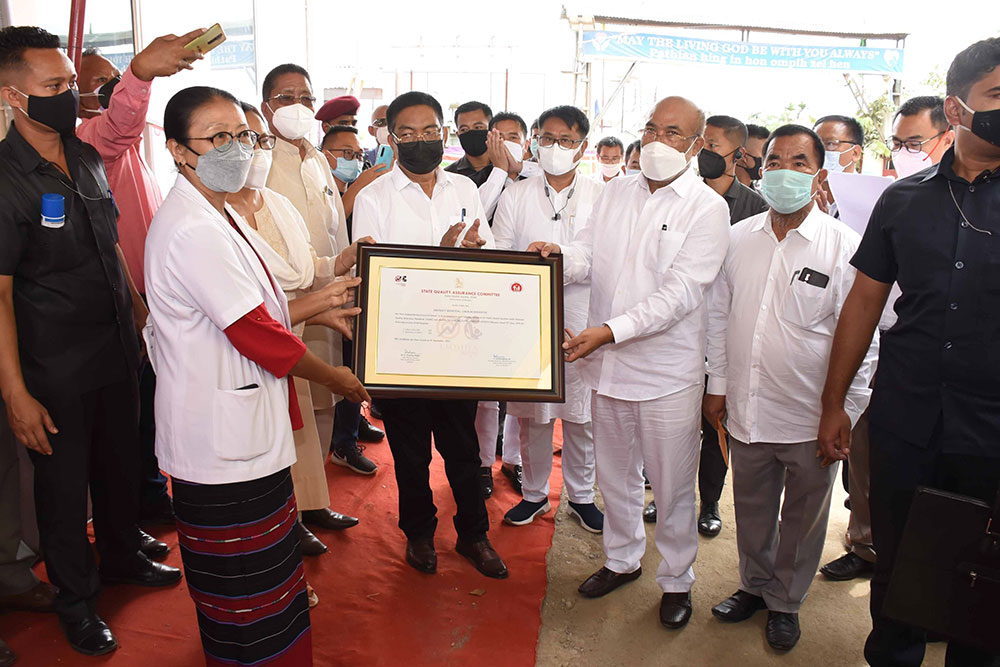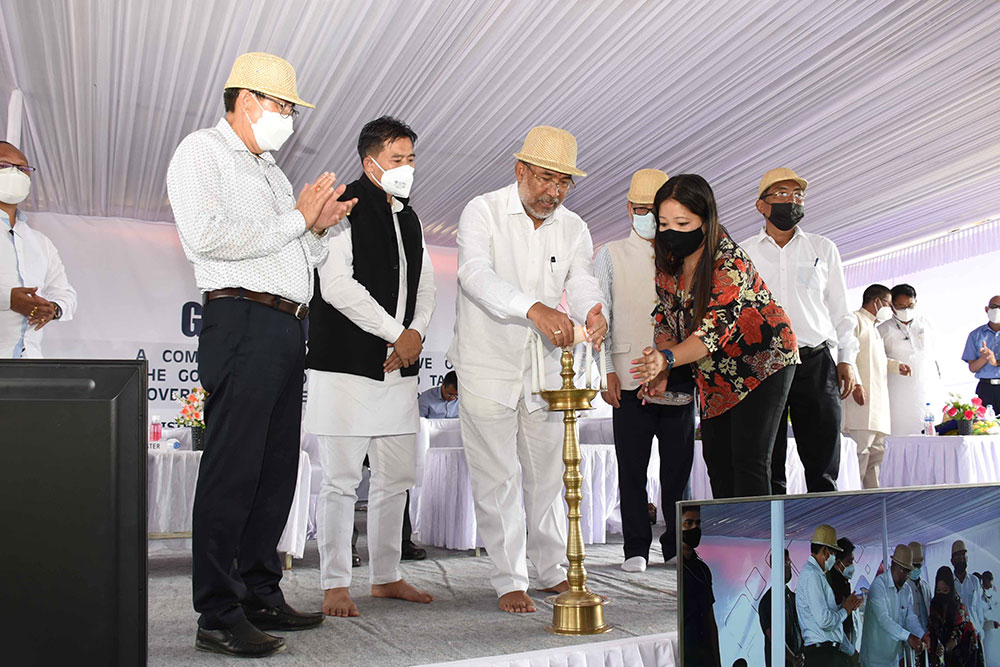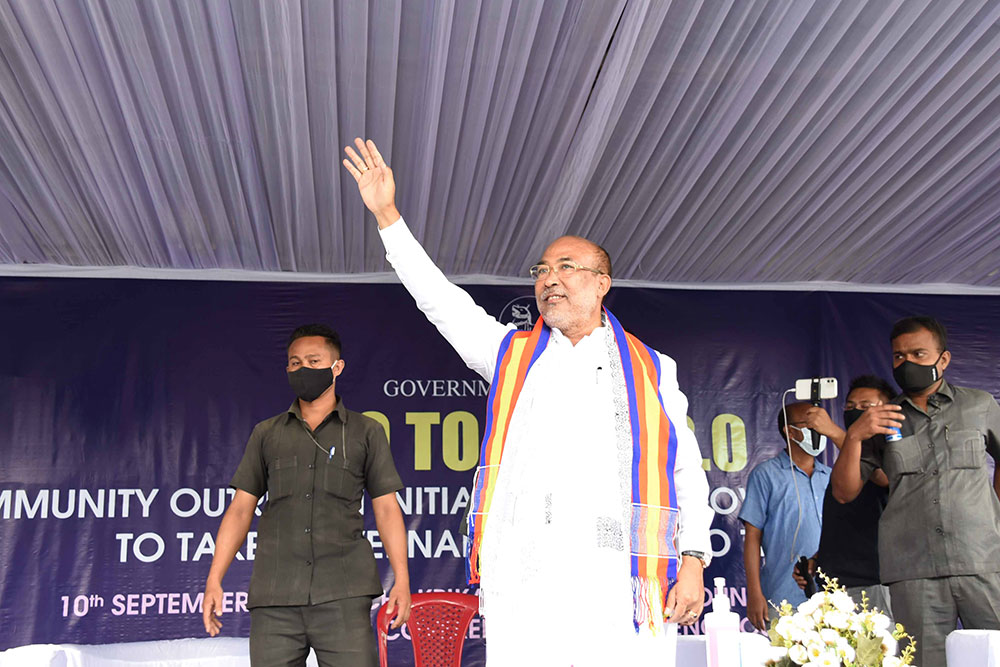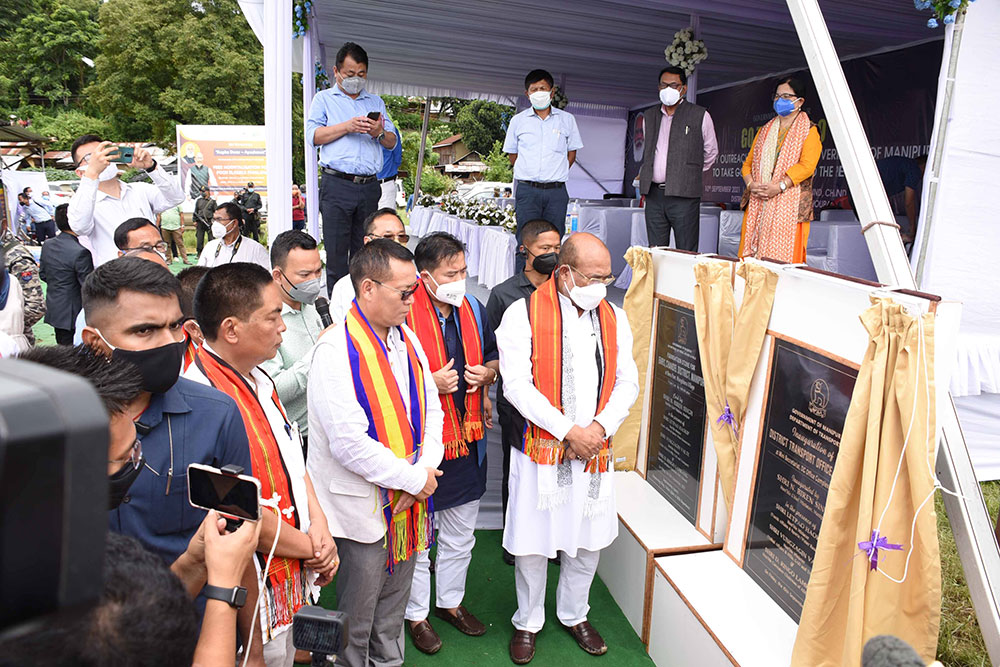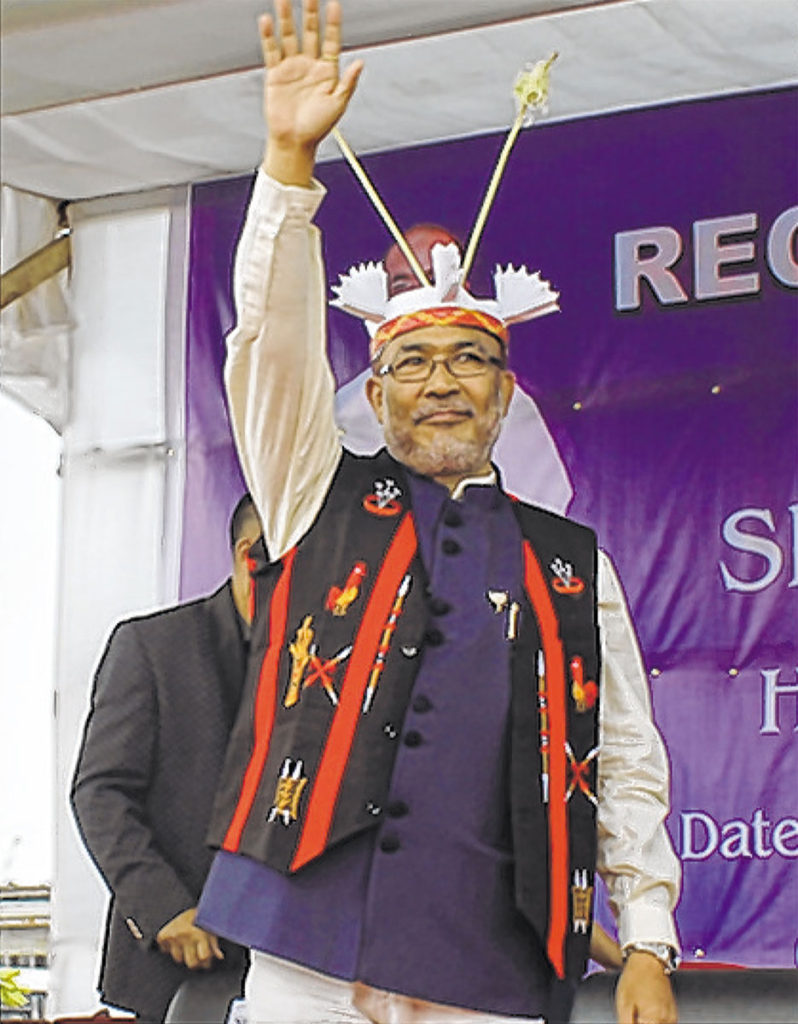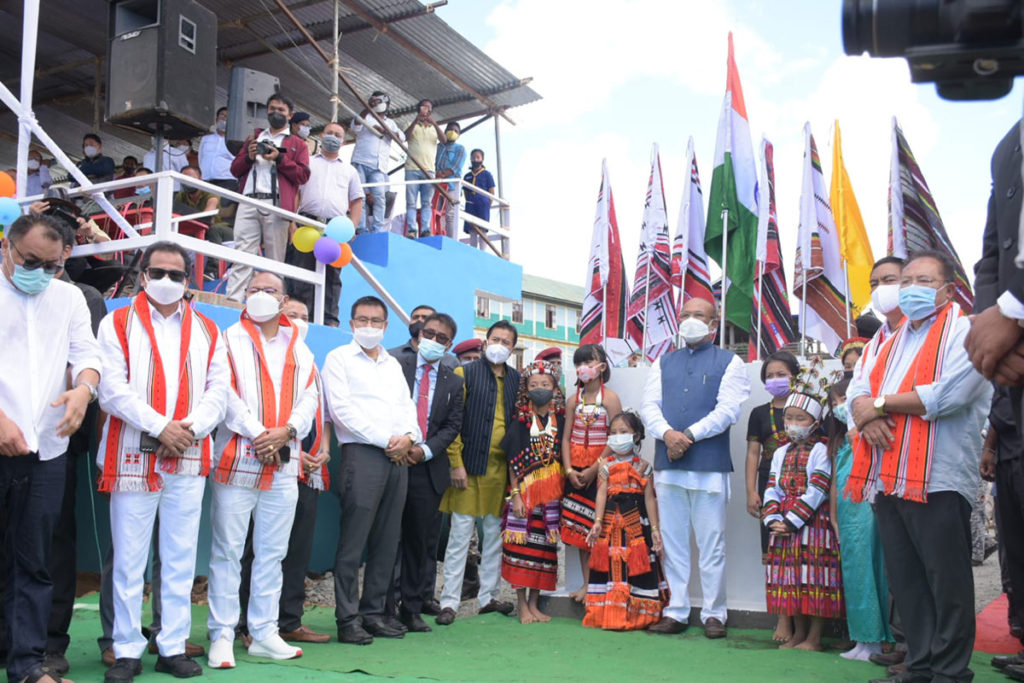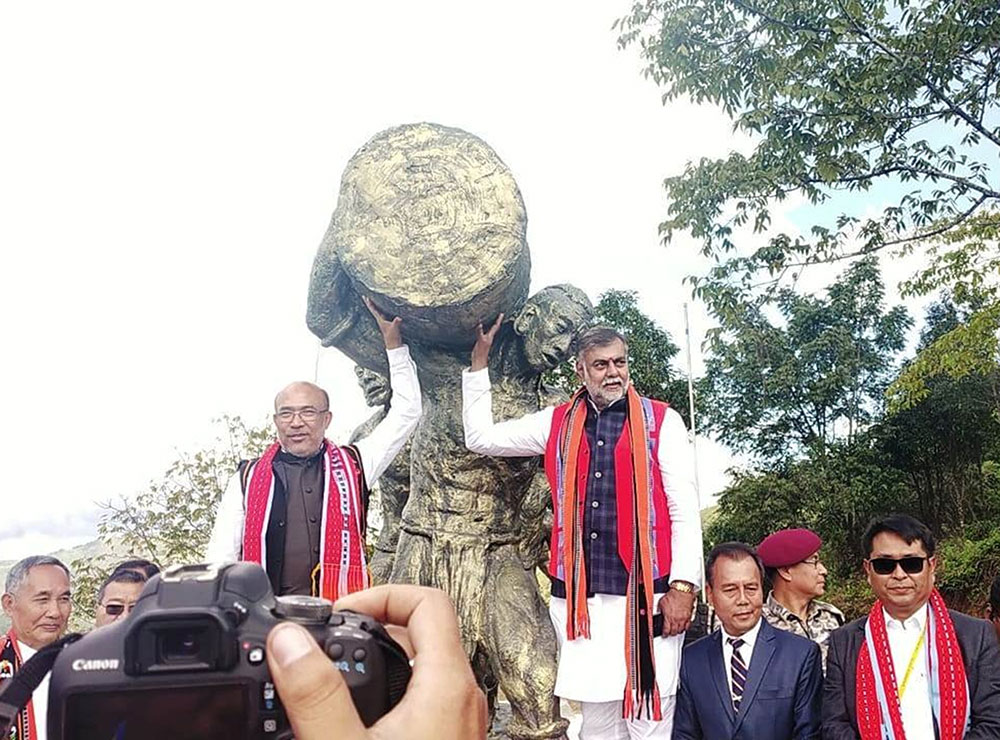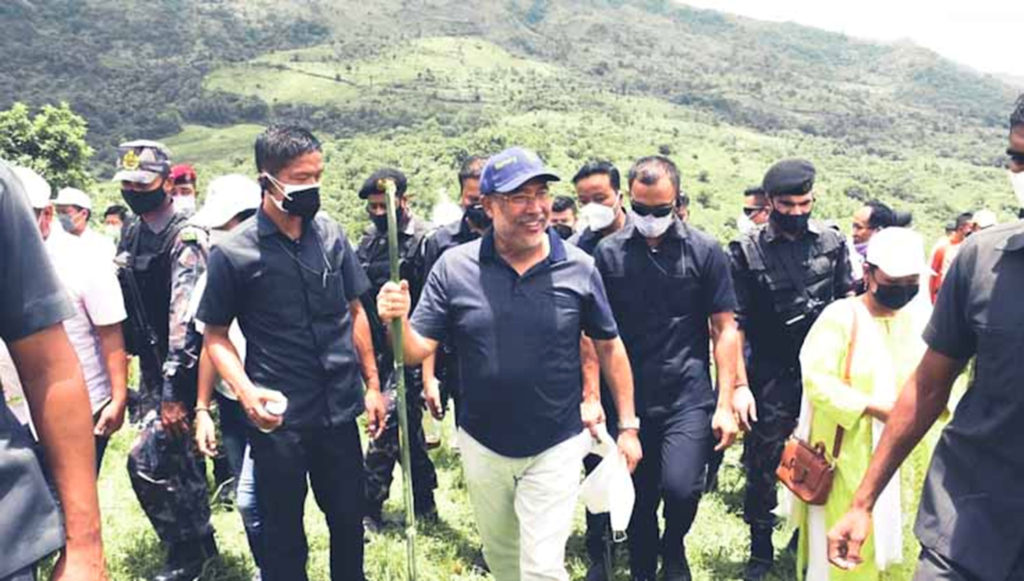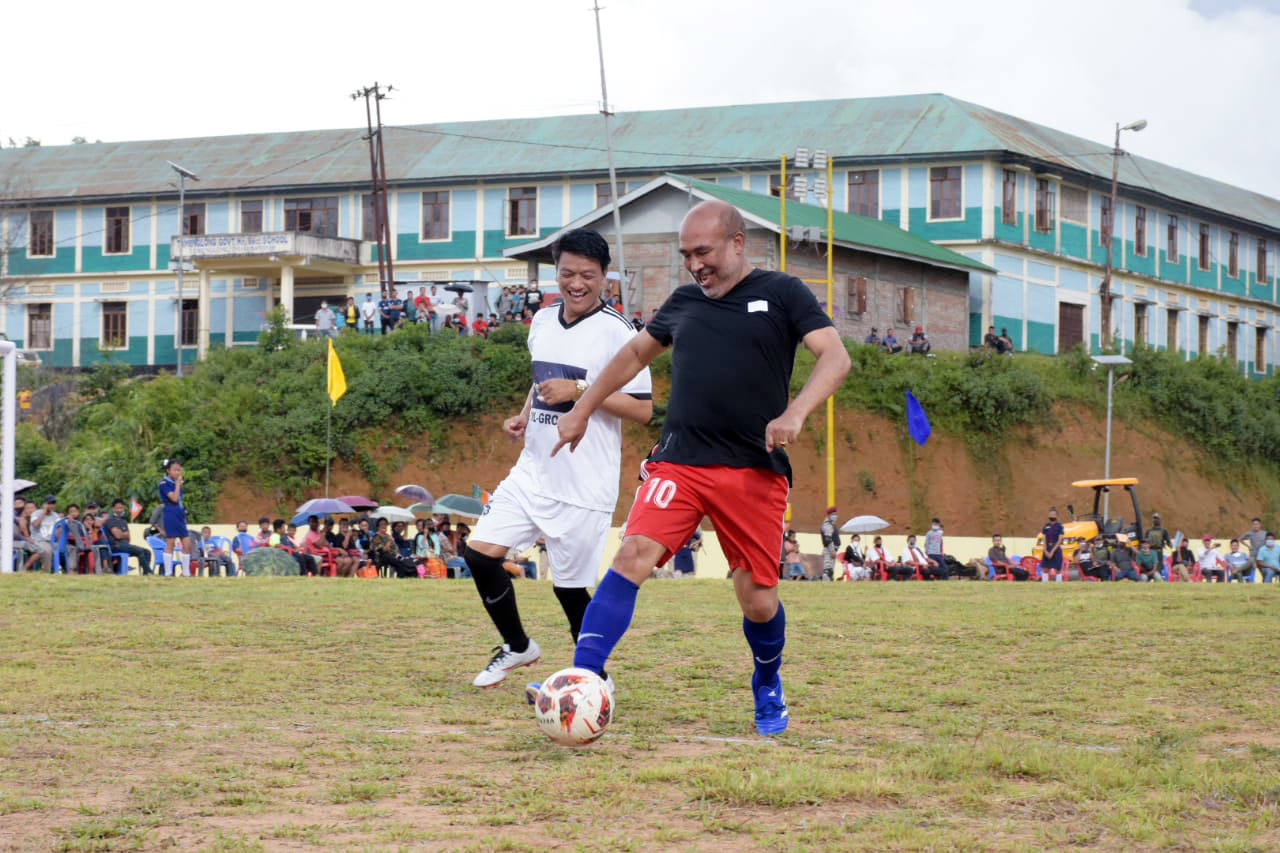
When N Biren Singh was sworn in as the first-ever Bharatiya Janata Party’s (BJP) Chief Minister in Manipur, it indicated a profound shift in the troubled state’s polity. He was taking over the reins of power after 15 years of Congress rule. There was a yearning for change and the people were willing to place their confidence in this former footballer and journalist whose articulation of ideas for the state filled them with hope. “I am very fortunate that people put their trust, hope and confidence in me to bring about a positive sustainable change towards an inclusive and prosperous society,” he tells The NorthEast Stories in this wide-ranging interview.
There’s quiet doggedness about Biren that strikes you when you first meet him. That, and his athletic gait. He is determined to transform Manipur but he must do it slowly and strategically.
One of the first policy decisions Biren took was Imphal Evenings where shops were encouraged to stay open till 9 pm and people were urged to shed their fears and step out of the safety of their homes to run errands or just enjoy an evening out. For a people that had become accustomed to a deathly quiet after 6 pm, the assurance from the state that Imphal was theirs to embrace was almost cathartic.
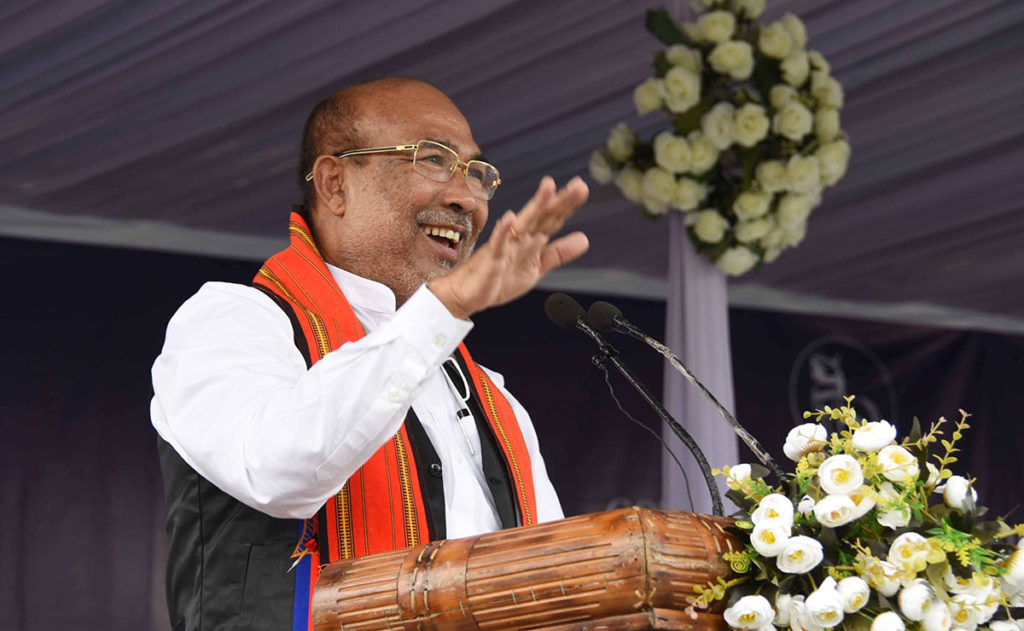
Manipur has always been considered one of the hardest states in the Northeast to administer. Its long history of separatist insurgency and internecine conflict have meant that generations of people have lived under the shadow of the Armed Forces Special Powers Act. For the ordinary Manipuri, who, till now, had learnt to negotiate life around conflict and the state’s response to it, a seemingly simple but meaningful measure like “Imphal Evenings” meant that they could actually begin to hope. The message itself was powerful.
As was the CM’s ambitious Go to the Hills/Go to the Villages outreach initiative which told the long-neglected people of the state’s far-flung hills that the government was as much theirs as it was the valley’s. It signalled that the administration would no longer be Imphal-centric and was serious about bridging the “emotional and developmental divide” that had festered for so long among the people of the state. This geographical divide could not only be overcome with investment in infrastructure but the government’s developmental initiatives would now be taken directly to the people, especially in hard to access areas. State cabinet meetings were held at hill district headquarters, while the “Go to Village” mission ensured 217,051 benefits and services were delivered right at the doorstep of 306,026 beneficiaries.
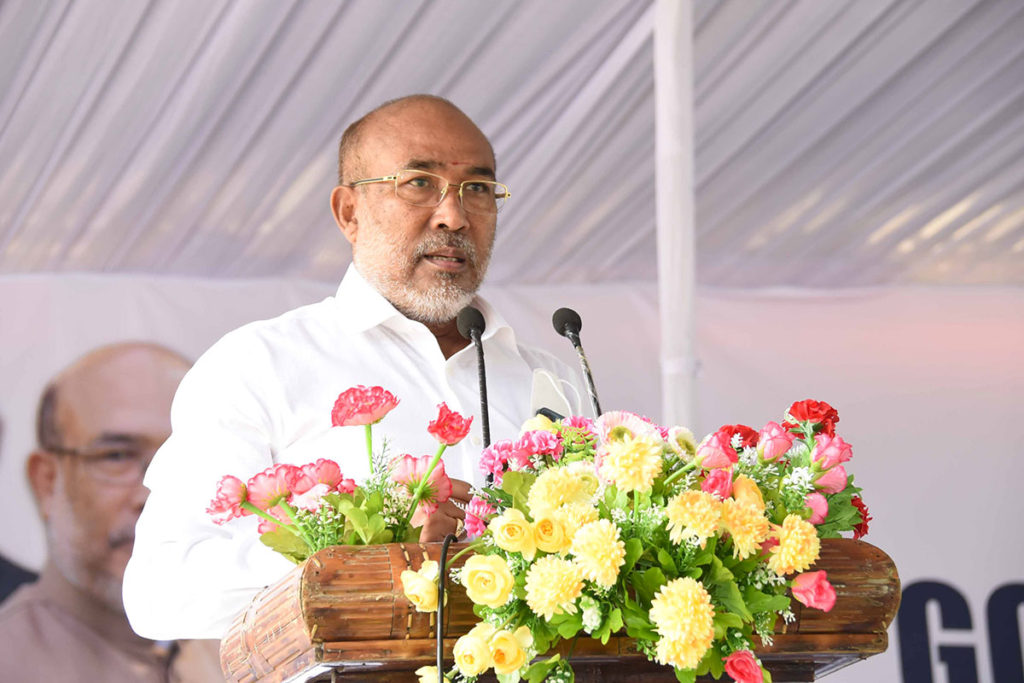
A firm believer in “human-oriented politics” Biren has always been known among his friends (particularly his football and journalist friends) for his never-say-die attitude. His former colleagues speak of his pragmatism and his ability to work inclusively and strategically when he was President of the All Manipur Working Journalist Union and editor of the vernacular Naharolgi Thoudang daily. No wonder then that when Covid19 struck this landlocked state, despite its poor health infrastructure, Biren was able to stem the contagion by implementing some simple practical measures and prioritizing government resources towards much-needed ventilators and oxygen plants.
Of course, his critics have their grouses and more. One of them being that he seldom exhibits a true sportsman spirit when it comes to criticism.
In this interview with The NorthEast Stories, Chief Minister Biren Singh tells us about his dreams for the state and how he hopes to heal a fractured society. Ahead of the state’s Legislative Assembly Elections (to be held in March 2022), he speaks passionately about Manipur’s tremendous potential, of his plans to leverage the state’s rich organic legacy through the Manipur Organic Mission Agency (MOMA) and its abundant produce and his firm belief that if government policies are people-oriented, it will dissipate any simmering discontent. “My mission in life has just started,” he says.
Imphal Evenings
Your brainchild that began in October 2017 where locals were encouraged to come out of their; homes after dark. For the first time in our history, shops were allowed to stay open from 6 pm to 9 pm. These very hours were earlier considered the most dreaded hours. What is the message that you are conveying to the people through this?
“Imphal Evening”, which was one of the first initiatives taken up by the BJP-led government, was indeed historic. This was so because, for decades, the people of the state have been living in fear, afraid of venturing out of their homes, especially at night due to the long history of insurgency and law and order issues.
Imphal Evenings was meant to send out the message that peace has come to the state, that people need not be ruled by fear in their hearts anymore, that people can come out and have a life in the evening, that economic activities can continue after dark. Imphal Evening also served as a harbinger of change towards a “New Manipur”, It was not merely about appreciating nightlife.
The objective is definitely beyond appreciating nightlife. In your view, what are the objectives?
It sent out a positive message - to unlock the (state’s) untapped potential, to promote tourism, to provide proper space for recreation for the citizens to enjoy quality time with their friends, relatives and family members. It also served as a platform to channelise the dynamism, creativity and innovation of the people, especially the youth through the promotion of inspiring local cuisines at the food stalls, to organising debates, stand-up comedy shows and other activities.
At one level, Imphal Evenings brought back trust and reassurance that was long lost – do you think this is an important step towards building lasting peace and confidence?
Building lasting peace and confidence is a continuous process and a collective endeavour. This government is of the firm belief that achieving the collective goal of inclusive development has to be on the foundation of peace, trust and confidence. In this regard, Imphal Evenings is an important step as it carries a significant message and demonstrates our intent towards building a peaceful and vibrant Manipur.
What is the biggest impact of Imphal Evenings at a political, economic and sociological level?
As alluded to earlier, long pending unresolved political issues over the decades had widened the trust deficit, adversely affecting the law-and-order situation in the state and hampering socio-economic development. The initiative of Imphal Evenings helped shake off years of psychological inertia, of fear and distrust, unshackling the minds of individuals and communities to aspire towards new possibilities and opportunities. It also created a generally positive vibe that translated into spurring economic activities, innovation and entrepreneurship beyond Imphal Evenings to other areas.
Go to Village/Go to the Hills
This mission was launched in all of Manipur’s 60 villages and 60 Assembly constituencies with a view to practising “human-oriented politics.” The existing divide between villages in the hills and valley is well known and it only widened over the decades. Through this initiative, how do you commit to deliver “good governance and bring inclusive development in the state” and most importantly, to ensure that the mission does not remain only on paper?
The government is fully committed to bridge the emotional and developmental gaps that unfortunately existed between communities for a long time in the state. This commitment is reflected in the launching of ambitious outreach programmes such as “Go to Hills” and “Go to Village” to transform the lives of the rural communities as one of the first initiatives of this government.
State Cabinet meetings were held at various headquarters of Hill District as part of “Go to Hills” to bring the government closer to the people. Under the “Go to Village” mission, 306,026 beneficiaries were enrolled and 217,051 benefits and services were delivered at the doorsteps in all the 2,691 census villages of the state, ensuring that government programmes reach the intended beneficiaries.
The decades-old grouse that the hills are always excluded from the development agenda even though the hill districts of Manipur comprised 89 per cent of the geographical area, while the valley comprising just 11 per cent area had 40 seats. Besides, around 80 per cent of the funds meant for the development in the state are invariably consumed by the valley. How will you bring about balance and ensure you win back the confidence of the hill people?
The emotional and developmental gaps that exist between communities in the state for a long time is, unfortunately, an outcome of a complex historical legacy and competing political narratives of the past. I firmly believe that the way forward for the state in today’s interconnected world has to be one based on mutual respect, trust and guided by a shared vision for the collaborative and collective development of the state and welfare for all.
My priorities were set from Day One. Why is there a developmental deficit in the hill districts? I do not agree that most of the developmental funds meant for the state are being gobbled up in the valley. As I found out, the fault was in budgeting. Building roads or other infrastructure in the hill areas is more costly than in the valley. So, in order to balance the gap, we need to invest twice the amount which is generally allocated in the valley for any development project. I was lucky that I have been able to convince Hon’ble Prime Minister Narendra Modiji to introduce topographical need-based budgeting for the hills in the development sector. Tamenglong district is the first beneficiary of this perspective.
One of the first initiatives taken up by my government in this regard, include programmes such as “Go to Hills”, “Hill Leaders Day” and “Go to Village”.
Taking the government to the doorsteps of the people through these missions had a significant impact in bridging the emotional and developmental gaps. Such efforts also positively transform the attitudes and aspirations of the people.
The mission cannot guarantee change overnight – these are no doubt positive steps toward inclusive development. What are the challenges and roadblocks considering it is indeed a herculean task – and something never conceived by previous leaders?
No doubt it’s a herculean task but I believe that if one puts one’s mind and efforts into it sincerely then anything can be achieved collectively.
“Go to the Village” was taken up under mission mode and for a start, all 2,691 census villages were covered with the enrolment of 3,06,028 beneficiaries. Challenges and difficulties are expected along the way and would be dealt with accordingly. What is important is that the gains made in the past few years towards inclusive development need to be consolidated and further expanded.
To commit to reaching out to citizens at their doorstep is idealistic if not impossible – it is designed to be in phases for practical reasons. How exactly would this work to ensure schemes and benefits are given to very deserving people?
One of the successes of the mission was that deserving and left-out beneficiaries could get access to government schemes through facilities of on-the-spot verification and application submission.
I am certain that we would build on these experiences to ensure sustainable mechanisms in future for ensuring wider participation of citizens and expanded coverage of beneficiaries towards inclusive development.
The use of digital technology and mechanisms such as Direct Benefit Transfers are also ensuring greater inclusiveness and transparency.
In the realm of this mission, where does education stand? Provision for educating in villages is important – needless to say, education can transform them. What are the means to ensure and safeguard that the education infrastructure is equipped to function and does not merely exist for the sake of it?
The education sector is another area where my government has accorded priority. The fruits of these efforts are reflected with Manipur topping all the smaller states of the country in terms of overall performance in school education in the School Education Quality Index (SEQI) report published by NITI Ayog in 2019.
Under the Prime Minister’s Jan Vikas Karyakram (PMJVK), 13 Model Residential Schools, 586 school buildings and 106 hostels for minority students were taken up.
The School Fagathansi Mission was also introduced with the aim to bring holistic quantitative and qualitative improvement in at least one high or higher secondary government school in every assembly constituency at an estimated cost of Rs 49.98 crore.
Various other initiatives have been taken up in the higher education sector like establishing a Dhanamanjuri University (DM University), a government engineering college and four private universities.
Horticulture
Pineapple has become a significant economic backbone for the state as a good section of farmers has been cultivating it as their major source of income. The Manipur Organic Mission Agency, a society under the state horticulture department, has been promoting pineapple farmers and helping them to market the fruit outside of the state. Would there be a sustained mechanism to market these locally-grown fruits outside the state at a reasonable transportation cost?
Around 220 metric tons of pineapples from Manipur were exported outside the state during the period 2018 – 2020. This year, despite the pandemic, for the fourth consecutive year, we started airlifting pineapples for export to cities like Gurgaon, Chandigarh, Mumbai, Delhi, Bangalore and Jaipur with a target to export 250 metric ton.
Other private firms also marketed more than 800 MT of fresh fruits and spices outside Manipur with institutional support from MOMA, benefitting a large number of farmers.
In addition to fruits, organic Black Rice from the state is also being exported not only to other parts of India but also recently to Europe.
The state government will continue to provide all support and assistance to farmers to sustainably expand the market for their produce.
How do you foresee the changes that rail connectivity will bring to the state especially for horticulture products that are otherwise perishing for want of a better market?
Rail connectivity will no doubt give a significant boost to trade and commerce in the state. In addition to railways, the cargo terminal planned at the airport will further strengthen connectivity infrastructure in the state. To ensure better remuneration for farmers and to minimize wastage, cold storage units are being set up in different parts of Manipur.
How far away is Manipur from innovating its variety of local food products?
Youth and entrepreneurs in Manipur, in the past few years, have infused enormous dynamism and innovation in the area of local food products. Just to name a few, some have used local food products and infused them with chocolates and tea, while others used black rice flour to make bakery items. It is also encouraging that cultivation of strawberry, apple and other exotic fruits are also being taken up in the state.
Manipur’s Start Up scheme also extended support to many such food entrepreneurs in addition to the support extended under the Horticulture schemes.
Apart from pineapple, Manipur is blessed with abundant fruits and ingredients that hold potential and promise. How can your government provide a good ecosystem for entrepreneurs with ideas?
As already alluded to earlier, various means of support are already being provided to farmers and entrepreneurs given the tremendous potential of the state in the agro sector.
Crops like turmeric, ginger, king chili, passion fruit, kiwi fruit, chakhao, HYV rice and maize have been identified as high-value export-oriented crops.
Farmers in the state were extended marketing support for their produce. Under the Market Intervention Scheme a revolving fund of Rs. 3.00 crore was provided. The Moma Market app was also launched to cater to the daily requirement of fresh vegetables and fruits. In addition, planting material is distributed, and support extended for micro-irrigation to increase productivity and promote efficient use of water. As part of our war on drugs, cultivation of alternative crops to poppy plantations are also being promoted.
As possibly a rare leader who has personally gone beyond the comfort zone of being valley-centric – your visit to far-flung areas and particularly Parbung for the first state-level ginger festival-cum-business summit signals hopes and promise. Would something like this be replicated in other districts? Where and when do you think Manipur, which is endowed with rich horticulture products, can claim its place in the larger market sphere in India or beyond?
These visits reflect my personal conviction and commitment that building a prosperous and peaceful Manipur has to be a collective, harmonious and inclusive process. I am very happy that I could make all these trips to far-flung parts of the state as I got to personally see and meet the people, to understand their challenges, concerns and aspirations.
A lot has already been done to promote the rich and diverse horticulture products in the state in just the last few years despite the pandemic. As mentioned earlier, produce from the state continues to be exported not only to other parts of the country but also outside India. The state government will continue to strengthen its efforts to promote our food products and support the farmers.
I am sure we are already on our way to claim its rightful place in the markets beyond Manipur.
Keeping fit and motivated
How do you keep yourself motivated? What is the most difficult task as a leader in a highly polarised state like Manipur?
I am very fortunate that many people put their trust, hopes and confidence in me to bring about a positive, sustainable change towards an inclusive and prosperous society. These aspirations and expectations keep me motivated to always give my 100 per cent in the service of the people.
It is true that Manipur has its own challenges due to its history, geography and decades of contested and overlapping narratives. Effectively dealing with any task, difficult or otherwise, for a leader is part and parcel of their duties and responsibilities. I personally feel that any issue can be amicably resolved through peaceful dialogue based on foundations of trust and respect.
How do you unwind and relax?
I work 24x7. My mission in life has just started. How can I relax? However, I managed to unwind in the morning on the treadmill.
As a former journalist, what are things that you miss about being a journalist? Do you still write, or at least jot down your thoughts?
My mind still works like a journalist and I am trying hard to put into action the ideas that I shared with the people during my journalistic career.
Do you have time to read? What are the kind of books you love reading?
Now, my reading is devoted to policies framed by officials and how to make them more humane and people-oriented.
Youth of Manipur
Considerable number of Manipur’s youth have left as they felt the state has failed them. I am an example of that: I left home when I was 13 for my higher education and then to build a career. Many in my generation also left home. Are you concerned about the plight of the state’s youth? Is it possible at all for your government to lure them back to be assets for the state?
We all must be proud that Manipuris across the globe have been achievers and contributors in different walks of their life. In that sense, our contribution to nation-building is significant in spite of being a small state. The Manipuri diaspora also plays a vital role in infusing new ideas and initiatives for the progress and prosperity of Manipur. They as ambassadors of our rich culture and heritage can also promote tourism and our products wherever they are based.
Over the years, the security scenario has significantly improved and as the land gateway of India into ASEAN there have been numerous opportunities. To capitalise on these untapped opportunities, provided by the changing dynamics in the region, many have chosen to come back home.
I am encouraged to see that many such entrepreneurs have decided to use their expertise and experiences to set up new businesses and enterprises in Manipur. These endeavours will go a long way in providing jobs and opportunities to the youth in the state and in transforming the development landscape in Manipur.
Tackling Covid
What have been the unique challenges for Manipur in tackling Covid so far and how differently have you dealt with the problem? Will this exercise help the state in its preparedness during a future medical emergency?
Manipur is a small state in a remote corner of the country without manufacturing units for medicines, PPEs, ventilators, concentrators, etc. Therefore, we had to be very proactive to ensure adequate supply and timely availability of critical equipment and medicines to effectively tackle the pandemic.
The demand for oxygen in the second wave was very high. To ensure that the supply of oxygen was streamlined, I immediately constituted a State Oxygen Committee under a senior IAS officer and took immediate steps to ensure that there was no shortage of oxygen.
At the beginning of the second wave, the state government had only 25 D-Type cylinders but we quickly increased it to more than 5,000 cylinders while continuously monitoring the oxygen situation 24x7. Subsequently, with the setting up of PSA Oxygen Plants and LMO plants, the oxygen supply scenario has improved significantly.
We have also been giving focus to the vaccination drive. Now, about 60 percent of our eligible population are vaccinated. This was made possible due to the collective efforts of officials, local MLAs, local clubs and civil society organisations.
For future emergencies, we have increased Covid beds, including for paediatric cases. Today, we have 3,547 beds in Covid Care Centres, 1,423 beds in Covid Hospitals, including 223 ICU beds and 8,376 beds in Community Home Isolation Centres.
You had mentioned the oxygen plants being set up in the state. Could there be details, please?
The state government did not have any PSA oxygen plants earlier. Now we have seven PSA plants, including hill districts like Ukhrul, Senapati, Chandel and Churachandpur. We have also set up two LMO plants of 10 KL and 20 KL capacity at Imphal. We are installing twelve more PSA plants, under PM CARES.
Press and Freedom
The arrest of a journalist in Manipur under NSA has not been taken well. Please comment?
In every democracy, the press is considered the fourth pillar. Expressing opinions and views freely are fundamental to strengthening the democratic process and our Constitution has rightly guaranteed every citizen the fundamental right to free speech and expression.
However, at the same time, we also have to be mindful that these rights are not absolute and the constitution has imposed reasonable restrictions.
Photos Courtesy: The Sangai Express
